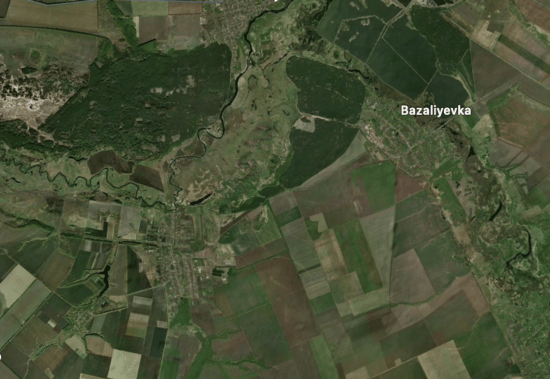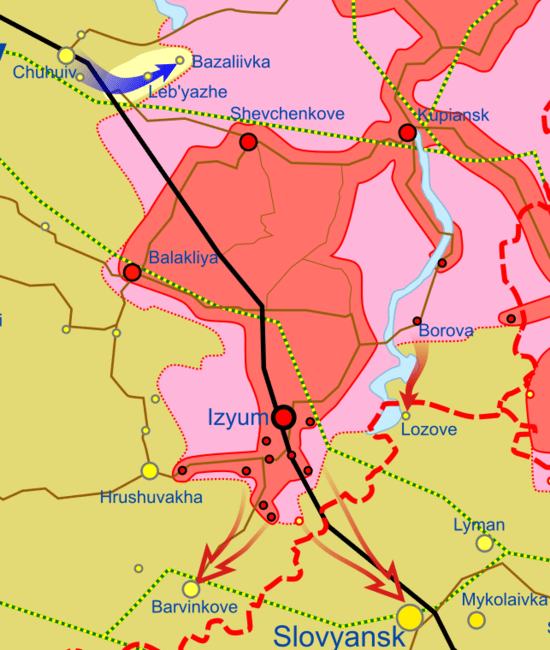Ukraine update: Ukraine makes a play for Izyum salient supply lines
This post was originally published on this site
If you’ve been seeing the words “Izyum salient” from me and Mark Sumner lately, it’s because the Russian-held city is one of two pivotal cities for Russia’s designs on the eastern Donbas front. In short, with little progress pushing out from pre-invasion rebel-held territory (in purple below), Russia is attempting to encircle entrenched Ukrainians from Mariupol in the south, and Izyum in the north. The effort looks like this:
That body of water you see northeast of Izyum is the Oskii river. Ukraine has blown the river crossings, forcing Russia to loop to its north to get to Izyum. Reinforcements and supplies coming in from Russia have to travel down those same roads, which are in range of Ukrainian artillery pounding them from the west.
A military salient is a projection into enemy territory, and the Izyum salient is particularly long and exposed. There are an estimated 15,000 troops around Izyum according to Ukrainian General Staff, and they’re all dependent on those long supply lines to feed a combat unit’s exhaustive ammunition, fuel, spare part, and food demands. So while Russia tries to push that salient further south, Ukraine is working to cut off those supply lines.

Kupiansk is at the crossroads of everything. The rail lines from Russia, and others from the Russian-occupied east, connect to the city, making it a natural resupply point for this entire front.
If the Ukrainians were to somehow reach the city, the Izyum salient would be fully cut off.
And they’re trying! This weekend Ukraine liberated a handful of settlements to Kharkiv’s southeast. At the same time it also made headway pushing Russians north of the city toward the Russian border. Given that there’s no real danger of a Russian offensive on the city, why expend the effort? Russian artillery can still strike Kherson from across the border in Russia, but it would now be out of range of Ukrainian artillery striking those supply lines south of Kherson. Additionally, Ukraine might want to avoid the creation of a “Kupiansk salient,” thus the need to secure that northern flank.
All that said, there is a Ukrainian salient forming, so why isn’t Russia raining artillery on those advancing troops? This is what the terrain looks like around those newly liberated settlements:

Like the rest of the region, it’s flat, mostly open farmland, punctuated by the occasional grove of trees (which are still not fully foliated). There’s no reason Russia couldn’t pound advancing Ukrainians the way Ukraine pounded that Russian supply column in the video above. Down south near Kherson, similar open terrain has hampered Ukraine’s offensive to take the city, as approaching Ukrainians face a barrage of artillery fire. It’s one major reason Ukraine has been begging for more artillery, counter-battery radar, precision-guided rounds, and suicide drones. Without artillery, Russia is nothing. Yet here, in one of the main Russian gathering spots, Russia doesn’t seem able to bring any extra guns to bear.
North of Izyum, some pro-Ukrainian sources are claiming Ukraine is counterattacking east of Izyum, up the eastern bank of the Oskil. Careful with those claims, as it is Russia attacking south along that bank:

Ukraine general staff claims they repelled an attack on Lozove on Sunday. Note how strategic that little hamlet is. If Russia takes it, they will be one step closer to securing an east-west connection between the Russian-occupied east and Izyum. Russia knows full well how tenuous and exposed its supply lines currently are, and is actively working to establish a more direct, more secure route.
Yet cracks are starting to appear in Russia’s war efforts. For one, separatist forces have been moved to the Izyum area. While Russia might prefer using proxy forces to avoid death notices back in the Motherland, fact is, they are next to useless. Untrained, unmotivated, and fully aware that they are nothing more than cannon fodder to the Russians. Where are all those supposedly elite troops pulled out of the Kyiv and Sumy axes? They don’t seem to be making their way back into Ukraine in the expected numbers.
Meanwhile, the Ukrainian General Staff announced that “In the territory of Donetsk and Luhansk [Donbas] regions, ten enemy attacks have been repelled, fifteen tanks have been destroyed, twenty-four units of armored and ten units of automobile equipment, as well as three enemy artillery systems.” As usual, the claimed equipment losses are less interesting than the daily confirmation that Russia continues its piecemeal drip-drip-drip attack strategy. Rather than gather its forces for one major overwhelming assault, it spreads out its combat power along numerous under-resourced attacks with little chance of success.
Yesterday’s 10 attacks are more than the five to six daily attacks we’ve been seeing the last few weeks, so tempo might be increasing. But if a major offensive were genuinely in the wings, why waste men and equipment on these doomed strikes? I maintain that Russia is incapable of fully opening the spigot.
For its part, Ukraine continues its consistently successful rope-a-dope strategy of trading land for blood any time it is dislodged from its prepared defenses (like the city of Izyum). Look at this video of a Russian armored vehicle heading south of Izyum toward the front lines:
As it drives, look at the armored vehicle graveyard it’s passing, and then take a look at the direction of the cannons: all pointing south. These are almost all Russian vehicles, destroyed on their southern approach. Every meter costs Russia equipment and troops it can no longer easily replace, while extending frail supply lines they struggle to protect and maintain. And while that terrain is mostly flat and open, there are also trees growing their spring leaves, and destroyed houses perfect for future ambushes. In this salient, Russia only controls the roads, and even so, only tenuously.
The Izyum weather forecast is fantastic:

General Mud will be around for a while. Plenty of time for Ukrainian artillery to keep pounding cold, wet, miserable Russians and separatists waiting to die. Also time for new Ukrainian artillery to arrive, adding to the pressure.
Russia’s pipe-dream pincer maneuver ain’t happening. And at this point, neither is any major offensive.
